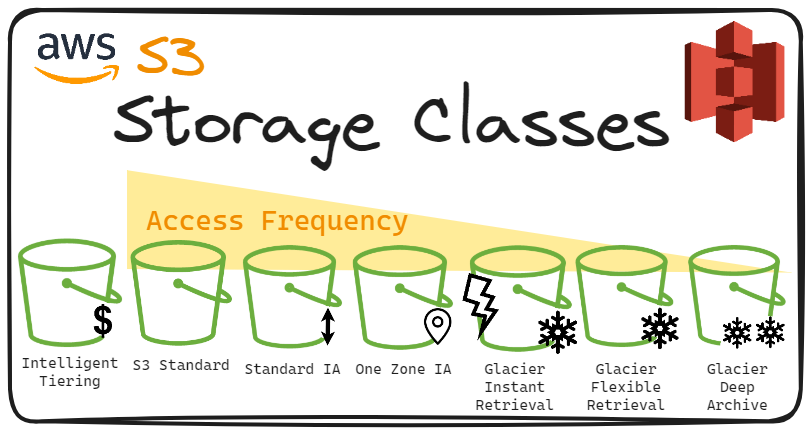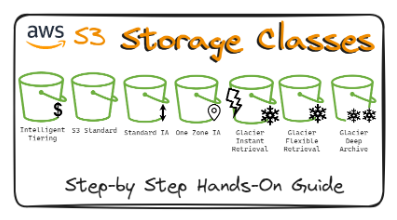Amazon S3 – Storage Classes
 Divya Mahajan
Divya Mahajan
Introduction:
Amazon S3 (Simple Storage Service) offers a range of storage classes tailored to different data access patterns and cost considerations. Each storage class is designed to optimize storage efficiency while meeting specific performance and durability requirements. This guide explores the various storage classes provided by Amazon S3 and their key features, use cases, and benefits.
S3 Storage classes for known and predictable access patterns
1. Amazon S3 Standard - General Purpose:
Default storage class.
High durability, availability(99.99% Availability), low latency.
Ideal for frequently accessed data.
Can sustain 2 concurrent facility failures
Use Cases: Big Data analytics, Mobile & gaming applications. Content distribution
2. Amazon S3-Infrequent Access (IA):
Designed for less frequently accessed data, which requires rapid access when needed
Lower cost than S3 Standard.
a) Standard-Infrequent Access (Standard IA)
99.9% Availability
Use Cases: Backups, Recovery, Archives
b) Amazon S3 One Zone-Infrequent Access (One Zone IA):
High durability (99.999999999%) , 99.5% Availability
Stored in a single Availability Zone, data is lost when Availability Zone is destroyed
Use Cases: Secondary backup copies of on-premise data, or data you can recreate
3. Amazon S3 Glacier Storage Classes
Amazon S3 Glacier offers cost-effective storage options tailored for data archival, with varying retrieval times to accommodate different access requirements:
a) Amazon S3 Glacier Instant Retrieval:
Provides near-instantaneous retrieval, suitable for infrequently accessed data.
Minimum Storage Duration: 90 days commitment.
Pricing: Includes storage fee and additional charges for retrieval.
Use Cases:
Storing historical financial data for periodic audits.
Archiving compliance documents for occasional checks.
b) Amazon S3 Glacier Flexible Retrieval:
Offers flexible retrieval options: Expedited (1-5 mins), Standard (3-5 hours), Bulk (5-12 hours)
Minimum Storage Duration: 90 days commitment.
Pricing: Based on storage duration and retrieval options.
Use Cases:
Backing up large datasets for occasional analysis.
Storing medical imaging data with intermittent reviews.
c) Amazon S3 Glacier Deep Archive:
Description: Lowest-cost storage for rarely accessed data, with retrieval times of up to 12 hours.
Minimum Storage Duration: 180 days commitment.
Pricing: Economical option for seldom-accessed data.
Use Cases:
Archiving research data sets for future reference.
Long-term storage of historical records for compliance.
S3 Storage classes for unknown or constantly evolving access patterns
Amazon S3 Intelligent Tiering
Amazon S3 Intelligent Tiering automatically optimizes storage costs by moving objects between access tiers based on usage patterns.
It serves as the default storage class for virtually any workload, offering 11 9s of durability within an AWS Region and millisecond-level access times.
Frequent Access tier (automatic): Default for regularly accessed objects.
Infrequent Access tier (automatic): For objects not accessed for 30 days.
Archive Instant Access tier (automatic): For objects not accessed for 90 days.
Archive Access tier (optional): Customizable storage duration.
Deep Archive Access tier (optional): Lower-cost storage options.
No Retrieval Charges: No charges for retrieval.
Use Cases:
Managing data with unpredictable access patterns.
Optimizing storage costs for datasets with varying access frequencies.
Perfect for data lakes, analytics, new applications, and user-generated content.
Transitioning Between Classes:
Manual or automated transitions using Lifecycle configurations.
Define rules based on object age.
Use Cases: Cost optimization, Compliance requirements
Comparison between Storage Classes
Here's a comparison table of the Amazon S3 Storage Classes:
| Storage Class | Data Durability | Availability | Availability SLA (%) | Zones | Min. Storage Duration | Min. Object Size | Retrieval Fee |
| Standard | High | High (99.99%) | 99.99 | Multi-AZ | None | None | None |
| Standard-IA | High | High (99.9%) | 99.9 | Multi-AZ | 30 days | 128KB | Per GB retrieved |
| One Zone-IA | High | Moderate (99.5%) | 99.5 | Single AZ | 30 days | 128KB | Per GB retrieved |
| Glacier Instant Retrieval | High | Moderate | N/A | N/A | 90 days | 40KB | Per GB retrieved |
| Glacier Flexible Retrieval | High | Moderate | N/A | N/A | 90 days | 40KB | Per GB retrieved |
| Glacier Deep Archive | High | Moderate | N/A | N/A | 180 days | 40KB | Per GB retrieved |
| Intelligent Tiering | High | High (99.9%) | 99.9 | Multi-AZ | None | None | None |
Amazon S3 Storage Classes: Hands-On | A Step-by-Step Guide
Delve into the world of Amazon S3 storage classes with our comprehensive guide. Learn how to optimize your storage costs and performance by leveraging different storage classes. Follow our step-by-step instructions to understand each storage class and its best use cases. For the full guide, visit Amazon S3 Storage Classes: Hands-On | A Step-by-Step Guide.
Summary
Standard - General Purpose:
- Default class with high durability and availability for frequently accessed data.
Infrequent Access (IA):
- Offers cost-effective storage for less frequently accessed data.
Amazon S3 Glacier:
- Tailored for data archival with varying retrieval times.
Intelligent Tiering:
- Automatically optimizes storage costs based on usage patterns.
Transitioning Between Classes:
- Manual or automated transitions based on object age for cost optimization.
Subscribe to my newsletter
Read articles from Divya Mahajan directly inside your inbox. Subscribe to the newsletter, and don't miss out.
Written by

Divya Mahajan
Divya Mahajan
Experienced Technical developer with 6+ years' global collaboration. Proficient in Python, Go, React, Next.js, Django, various databases, Cloud & DevOps (AWS EC2, Docker, Kubernetes), and Big Data tools. Skilled in data structures and algorithm, API development, and end-to-end software engineering. Excels in back-end development, front-end design, Root Cause Analysis, and product management to deliver superior user experiences. Holds a master’s degree in computer engineering.
